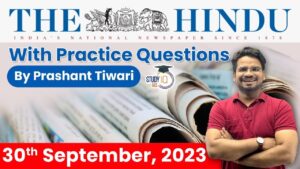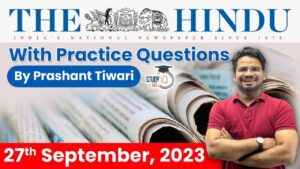The Hindu Newspaper Analysis for UPSC

The Hindu Newspaper Analysis 30 January 2023
- The Information and Broadcasting Ministry on Monday clarified that the topics of national importance and social relevance embedded in the programmes broadcast by private TV channels would qualify for their obligation under the “Guidelines for Uplinking and Downlinking of Television Channels in India, 2022” to telecast such contents for 30 minutes every day.
- The Ministry had earlier issued the guidelines on November 9 last year. Following consultations with the stakeholders, it has now come up with the advisory.
- It said the content could include the themes of education and spread of literacy; agriculture and rural development; health and family welfare; science and technology; welfare of women and the weaker sections of society; protection of environment and cultural heritage; and national integration.
- Stating that the advisory sought to achieve the objective of public service broadcasting by the private TV channels through voluntary compliance and self-certification, the Ministry said the list was indicative and could be extended to include similar subjects such as water conservation, disaster management, etc.
- It said the time for transmission of such contents would be flexible, except that any content transmitted from midnight to 6 a.m. would not be accounted for under the public service broadcasting obligation. While voluntary compliance and self-certification would be the guiding principles, the Ministry said broadcasters would be required to submit a monthly report on the Broadcast Seva Portal on or before the seventh day of the following month.
- The broadcasters will have to keep a record of the content telecast for a period of 90 days.
- “Broadcasters shall include a compliance certificate in the annual report. Foreign channels, downlinking in India [in languages other than those specified in the Eighth schedule of the Indian Constitution], shall be exempt from the obligation…The channels broadcasting predominantly [more than 12 hours] sports and devotional/spiritual/yoga content shall be exempt from furnishing the monthly reports on the Broadcast Seva Portal,” it clarified.
The Hindu Editorial Today

National Food Security Act (NFSA), 2013
- To provide for food and nutritional security in the human life cycle approach, by ensuring access to adequate quantities of quality food at affordable prices to people to live a life with dignity.
Coverage:
- The Act provides coverage for nearly 2/3rd of the country’s total population, based on Census 2011 population estimates.
- 75% of rural and 50% of urban population is entitled to receive highly subsidized food grains under two categories i.e Antyodaya Anna Yojana(AAY) households and Priority Households (PHH).
- The Act entitles 35 kg of food grains as per Antyodaya Anna Yojana Households per month, whereas 5kg of food grains per Priority Households per person.
- The eldest woman of the beneficiary household (18 years or above) is considered ‘Head of Family’ for the purpose of issuing ration cards.

- The Food and Agriculture Organization of the United Nations (FAO) has declared 2023 as the International Year of Millets. Millets have special nutritive properties (they are high in protein, dietary fibre, micronutrients and antioxidants) and special agronomic characteristics (drought-resistant and suitable for semi-arid regions).
- Two groups of millets are grown in India. Major millets include sorghum, pearl millet and finger millet, while minor millets include foxtail, little millet, kodo, proso, and barnyard millet.
- In 2019-20, the total offtake of cereals through the Public Distribution System (PDS) and the Integrated Child Development Scheme (ICDS) and also school meals was around 54 million tonnes. If about 20% of rice and wheat were to be replaced by millet, the state would have to procure 10.8 million tonnes of millet.
- The real problems are: first, the decline in the area under millet cultivation, and, second, the low productivity of millets.
- In conclusion, increasing the production of millets and reversing the decline in area cultivated are feasible steps but not easy, and require multiple interventions including scientific inputs, institutional mechanisms, financial incentives and in-kind support.
- Small farmers in hilly regions and dryland plains who are among the poorest households in rural India, are going to cultivate millets only if it gives them good returns.

- New Delhi says this extreme step is due to Pakistan’s intransigence over objections to two Indian hydropower projects in Jammu and Kashmir: the 330MW Kishanganga hydroelectric project (Jhelum) and the 850MW Ratle hydroelectric project (Chenab).
- India has argued since 2006, when the objections began, that the projects were within the treaty’s fair water use. However, Pakistan has refused to conclude negotiations with India in the bilateral mechanism — the Permanent Indus Commission of experts that meets regularly — and has often sought to escalate it.

- The Supreme Court is on January 31 scheduled to examine whether petitions challenging the validity of electoral bonds scheme need to be referred to a Constitution Bench.
- The petitions, which have been in limbo for about eight years, allege that the scheme has opened the doors for anonymous donations to political parties days before polls are due.
- “The amendments have removed the caps on campaign donations by companies and have legalised anonymous donations. The Finance Act of 2017 has introduced the use of electoral bonds which are exempt from disclosure under the Representation of Peoples Act, 1951, opening doors to unchecked, unknown funding to political parties.
Features
- Introduced with the Finance Bill, 2017, the Electoral Bond Scheme was notified on January 29, 2018.
- An Electoral Bond is like a promissory note that may be purchased by a person who is a citizen of India or incorporated or established in India.
- A person being an individual can buy Electoral Bonds, either singly or jointly with other individuals.
- The bonds are like banknotes that are payable to the bearer on demand and are interest-free.
- Only the Political Parties registered under Section 29A of the Representation of the People Act (RPA), 1951 (43 of 1951) and which secured not less than one percent of the votes polled in the last General Election to the House of the People or the Legislative Assembly of the State, shall be eligible to receive the Electoral Bonds.
Procedure
- The State Bank of India (SBI) has been authorised to issue and encash Electoral Bonds through its 29 Authorized Branches.
- The bonds are sold by the SBI in denominations of Rs 1,000, Rs 10,000, Rs 1 lakh, Rs 10 lakh and Rs 1 crore.
- One can purchase these bonds only digitally or through cheques.
- The Electoral Bonds can be encashed by an eligible Political Party only through a Bank account with the Authorized Bank.
- The Electoral Bond deposited by an eligible Political Party in its account is credited on the same day.
- Electoral Bonds shall be valid for fifteen calendar days from the date of issue and no payment is being made to any payee Political Party if the Electoral Bond is deposited after expiry of the validity period.

- The government will soon kick off the process to set up the Sixteenth Finance Commission, with the Finance Ministry likely to notify the terms of references for the constitutional body, tasked with recommending the revenue sharing formula between the Centre and States and their distribution among States, towards the latter half of this year.
- The Fifteenth Finance Commission was set up in November 2017 with a mandate to make recommendations for the five-year period from 2020-21. While the Constitution requires a Finance Commission (FC) to be set up every five years, the 15th FC’s mandate was extended by a year till 2025-26, breaking the cycle.
- In late 2019, the Commission was asked to give a standalone report for 2020-21 and another report for an extended five-year period till 2025-26.
- The last time an FC was granted a six-year time frame was for the 9th Finance Commission, formed in June 1987. It was asked to submit a single year report for 1989-90 and a five-year report for the five years till 1994-95. These reports were submitted in 1988 and 1990, when the country’s Finance Ministers were S.B. Chavan and Madhu Dandavate, respectively. The Tenth Finance Commission was still constituted in June 1992 within the five-year deadline specified by Article 280 of the Constitution, whic
Finance Commission
- Article 280 of the Constitution of India provides for a Finance Commission as a quasi judicial body.
- It is constituted by the president of India every fifth year or at such an earlier time as he considers necessary.
- Role of Finance Commission: To give its recommendations on distribution of tax revenues between the Union and the States and amongst the States themselves.
- Article 281 of the Indian Constitution related to the recommendation of the Finance Commission.
- Note: State Finance Commission for the States of India are constituted under the Constitution 73rd Amendment Act, 1992 to look after the matter of local governments.
Finance Commission – Composition
- The Finance Commission is made up of a chairman and four additional members appointed by the president.
- They serve for the duration set by the president in his order. They are eligible for re- appointment.
- Qualification: The Constitution empowers Parliament to set the qualifications of commission members and the way in which they should be chosen.
- As a result, the qualifications of the chairman and members of the commission have been set by Parliament.
The chairperson should be someone with public affairs expertise, and the four other members should be chosen from the following:
- A judge of the high court or one qualified to be appointed as one.
- A person who has specialised knowledge of finance and accounts of the government.
- A person who has wide experience in financial matters and in administration.
- A person who has special knowledge of economics.
Disqualification: Members may be disqualified if they are found to be of unsound mind, have committed a heinous act, or have a conflict of interest.
Q) Consider the following statements regarding the All India Survey on Higher Education (AISHE):
- It is conducted by the Pratham NGO in all States and Union territories.
- It covers all higher educational institutions located in Indian Territory.
Which of the above statements is/are correct?
- 1 only
- 2 only
- Both 1 and 2
- Neither 1 nor 2
उच्च शिक्षा पर अखिल भारतीय सर्वेक्षण (एआईएसएचई) के संबंध में निम्नलिखित कथनों पर विचार करें:
- यह प्रथम एनजीओ द्वारा सभी राज्यों और केंद्र शासित प्रदेशों में आयोजित किया जाता है।
- इसमें भारतीय क्षेत्र में स्थित सभी उच्च शिक्षण संस्थान शामिल हैं।
उपरोक्त कथनों में से कौन-सा/से सही है/हैं?
- केवल 1
- केवल 2
- 1 और 2 दोनों
- न तो 1 और न ही 2
Explanation :
Ministry of Education recently released All India Survey on Higher Education (AISHE) 2020-2021
About All India Survey on Higher Education (AISHE):
- It is conducted by the Ministry of Education since 2011.
- Coverage: It covers all higher educational institutions located in Indian Territory and imparting higher education in the country.
- Objectives:
- To identify and capture all the institutions of higher learning in the country.
- Collect the data from all the higher education institutions on various aspects of higher education.
- The survey collects detailed information on different parameters such as student enrollment, teacher’s data, infrastructural information, financial information etc.
Q) Aarhus Convention, 1998 is related to
- Conservation of Migratory Species of Wild Animals
- Governing actions to combat climate change through adaptation and mitigation
- Access to Information and Public Participation in Environmental Matters
- Control of Transboundary Movements of Hazardous Wastes and their Disposal.
आरहस कन्वेंशन, 1998 संबंधित है
- जंगली जानवरों की प्रवासी प्रजातियों का संरक्षण
- अनुकूलन और शमन के माध्यम से जलवायु परिवर्तन से निपटने के लिए कार्रवाई को नियंत्रित करना
- पर्यावरणीय मामलों में सूचना और सार्वजनिक भागीदारी तक पहुंच
- खतरनाक कचरे और उनके निपटान के सीमा पार आंदोलनों का नियंत्रण।
- The UNECE Convention on Access to Information, Public Participation in Decision-making and Access to Justice in Environmental Matters, usually known as the Aarhus Convention, was signed on 25 June 1998 in the Danish city of Aarhus. It entered into force on 30 October 2001. All of the ratifying states are in Europe and Central Asia.
- The Aarhus Convention grants the public rights regarding access to information, public participation and access to justice, in governmental decision-making processes on matters concerning the local, national and transboundary environment. It focuses on interactions between the public and public authorities.
Q) Consider the following statements regarding Olive Ridley turtles.
- They are found in warm waters of the Pacific and Indian oceans.
- Odisha coast is one of the largest mass nesting sites in the world.
- They are not found in the Atlantic Ocean.
Which of the above statements is/are correct?
- 1 only
- 1 and 2 only
- 2 and 3 only
- 1, 2 and 3
ओलिव रिडले कछुओं के संबंध में निम्नलिखित कथनों पर विचार करें।
- वे प्रशांत और भारतीय महासागरों के गर्म पानी में पाए जाते हैं।
- ओडिशा तट दुनिया के सबसे बड़े सामूहिक घोंसले के शिकार स्थलों में से एक है।
- ये अटलांटिक महासागर में नहीं पाई जाती हैं।
उपरोक्त कथनों में से कौन-सा/से सही है/हैं?
- केवल 1
- केवल 1 और 2
- केवल 2 और 3
- 1, 2 और 3
Explanation:
- The olive ridley is predominantly carnivorous, especially in immature stages of the lifecycle. Animal prey consists of protochordates or invertebrates, which can be caught in shallow marine waters or estuarine habitats.
- Common prey items of Olive Ridely Turtle include jellyfish, tunicates, sea urchins, bryozoans, bivalves, snails, shrimp, crabs, rock lobsters, and sipunculid worms.
- They are found in warm and tropical waters, primarily in the Pacific and Indian Oceans, but also in the warm waters of the Atlantic Ocean.
- This turtle and the related Kemps ridley turtle are best known for their unique mass nesting called arribada, where thousands of females come together on the same beach to lay eggs.
- The coast of Odisha in India is the largest mass nesting site for the olive ridley.
Q) When ocean temperatures get too hot, corals often experience ‘bleaching’ events. What does this mean?
- Corals submerge themselves completely under water, starving themselves of sunlight and air to breathe
- Corals move towards cooler waters
- Plants and animals living in the vicinity of corals die
- The symbiotic nature of the relationship between a certain plant and animal breaks down
जब समुद्र का तापमान बहुत अधिक गर्म हो जाता है, तो कोरल अक्सर ‘ब्लीचिंग’ घटनाओं का अनुभव करते हैं। इसका क्या मतलब है?
- कोरल खुद को पूरी तरह से पानी के नीचे डुबो देते हैं, खुद को सूरज की रोशनी और सांस लेने के लिए हवा से भूखा रखते हैं
- कोरल ठंडे पानी की ओर बढ़ते हैं
- कोरल के आसपास रहने वाले पौधे और जानवर मर जाते हैं
- एक निश्चित पौधे और जानवर के बीच संबंध की सहजीवी प्रकृति टूट जाती है
- Often mistaken for a form of vegetation, corals “are in fact an animal that lives in symbiosis with an algae, a plant,”
- Corals and algae “provide services for each other,” with the algae providing “up to 90% of the coral animal’s food” through photosynthesis
- “When ocean temperatures get too hot, this symbiosis, this relationship, breaks down”. “The algae is lost from the coral and causes the coral to look white,” effectively “starving” it.
- When a coral bleaches, it is not dead. Corals can survive a bleaching event, but they are under more stress and are subject to mortality.
Q) Consider the following statements about Pradhan Mantri Kisan Samman Nidhi (PM-KISAN):
- It is a Central Sector Scheme with 100% funding from the Government of India.
- It is being implemented by the Ministry of Agriculture and Farmers Welfare.
Which of the above statements is/are correct?
- 1 only
- 2 only
- Both 1 and 2
- Neither 1 nor 2
प्रधानमंत्री किसान सम्मान निधि (पीएम-किसान) के बारे में निम्नलिखित कथनों पर विचार करें:
- यह भारत सरकार से 100% वित्त पोषण के साथ एक केंद्रीय क्षेत्र की योजना है।
- इसे कृषि और किसान कल्याण मंत्रालय द्वारा कार्यान्वित किया जा रहा है।
उपरोक्त कथनों में से कौन-सा/से सही है/हैं?
- केवल 1
- केवल 2
- 1 और 2 दोनों
- न तो 1 और न ही 2
It was launched on 24thFebruary, 2019 to supplement financial needs of land holding farmers.
- Financial Benefits:
- Financial benefit of Rs 6000/- per year in three equal installments, every four month is transferred into the bank accounts of farmers’ families across the country through Direct Benefit Transfer (DBT) mode.
- Scope of the Scheme:
- The scheme was initially meant for Small and Marginal Farmers (SMFs) having landholding upto 2 hectares but scope of the scheme was extended to cover all landholding farmers.
- Funding and Implementation:
- It is a Central Sector Scheme with 100% funding from the Government of India.
- It is being implemented by the Ministry of Agriculture and Farmers Welfare.
Mains Practice Question:
Q) “Investment in infrastructure is essential for more rapid and inclusive economic growth.” Discuss in the light of India’s experience. (250 words) (2021)
“अधिक तीव्र और समावेशी आर्थिक विकास के लिए बुनियादी ढांचे में निवेश आवश्यक है।” भारत के अनुभव के प्रकाश में चर्चा कीजिए। (250 शब्द) (2021)


 The Hindu Newspaper Analysis 6 October 2...
The Hindu Newspaper Analysis 6 October 2...
 The Hindu Newspaper Analysis 30 Septembe...
The Hindu Newspaper Analysis 30 Septembe...
 The Hindu Newspaper Analysis 27 Septembe...
The Hindu Newspaper Analysis 27 Septembe...





















